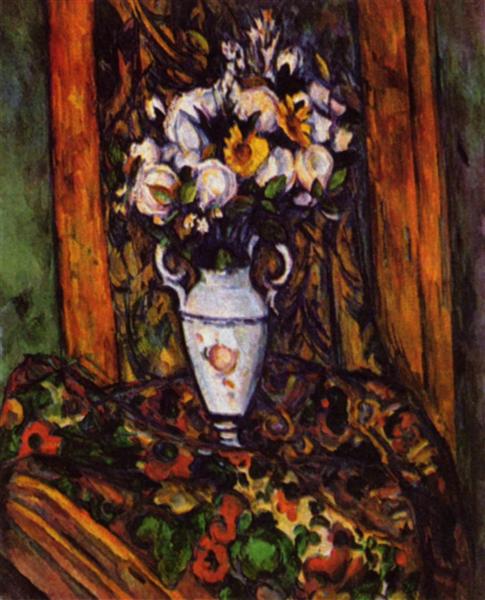Description
Paul Cézanne's Still Life - Vase of Flowers, painted in 1903, is a clear testament to the artist's mastery in the representation of space and form, fundamental elements that place him as one of the most influential figures in the transition to modernism in art. In this painting, Cézanne addresses the traditional theme of still life, providing his unique vision of the world through a careful and meticulous arrangement of elements, as well as a color palette that evokes both the vibrant life of flowers and the serenity of the domestic environment.
The vase, made of white and blue ceramic, is the central focus of the composition. The flowers, arranged loosely within the vessel, emerge with a palpable vigor that seems to defy the typical stillness of this pictorial genre. Cézanne uses a wide range of colors to breathe life into the flowers, from warm yellows to deep reds, which contrast harmoniously with the cooler shades of green and blue that predominate in the background and the table. This contrast not only creates a sense of depth, but also lends a dynamism that is characteristic of Cézanne's work.
The master employs a loose, modulated brushstroke technique that does not seek to faithfully represent reality, but rather to capture the essence of objects. The flowers appear to be in constant motion, as if the air around them were coming to life. Each stroke provides a tactile sensation that invites the viewer to a visual interaction beyond the merely superficial. The way Cézanne models the flowers with his characteristic simplification of forms—eliminating what he considers superfluous to concentrate on the volumetric construction of the vase—is emblematic of his innovative approach to composition.
The table, for its part, serves as a plane that connects the vase with the background, which is kept in a neutral tone, giving the flowers a space to stand out. In this respect, we could relate "Still Life - Vase with Flowers" to other contemporary works by Cézanne where the arrangement of the elements seeks practical visual balances, as in his famous series of still lifes and portraits. This act of balancing shapes, colors and spaces is what defines his style, which lays the foundations for the later developments of Cubism.
Interestingly, although the work is one of his many explorations into the still life genre, Vase of Flowers also reflects the artist's concerns with the perception of nature and its representation. Cézanne was deeply interested in how color and form could work together to create an emotional and psychological reality, rather than mimicking physical reality exactly. In this sense, the painting becomes not just a capture of static objects, but a meditation on the beauty and presence that they can offer to the observer.
As we look more closely at the work as a whole, we realise that although there are no depictions of human figures, the absence of 'characters' does not limit the narrative; on the contrary, it invites viewers to become part of the scene, to contemplate the beauty of domesticated nature. Cézanne, whose influence would extend throughout the twentieth century and beyond, challenges our conceptions of painting by reminding us that simplicity can be a powerful vehicle for complex expression. Thus, Still Life - Vase of Flowers is not only a masterpiece in which colour and form are amalgamated, but it is also a reflection on life itself, its transience and its charms.
KUADROS ©, a famous painting on your wall.
Hand-made oil painting reproductions, with the quality of professional artists and the distinctive seal of KUADROS ©.
Painting reproduction service with satisfaction guarantee. If you are not completely satisfied with the replica of your painting, we will refund 100% of your money.

